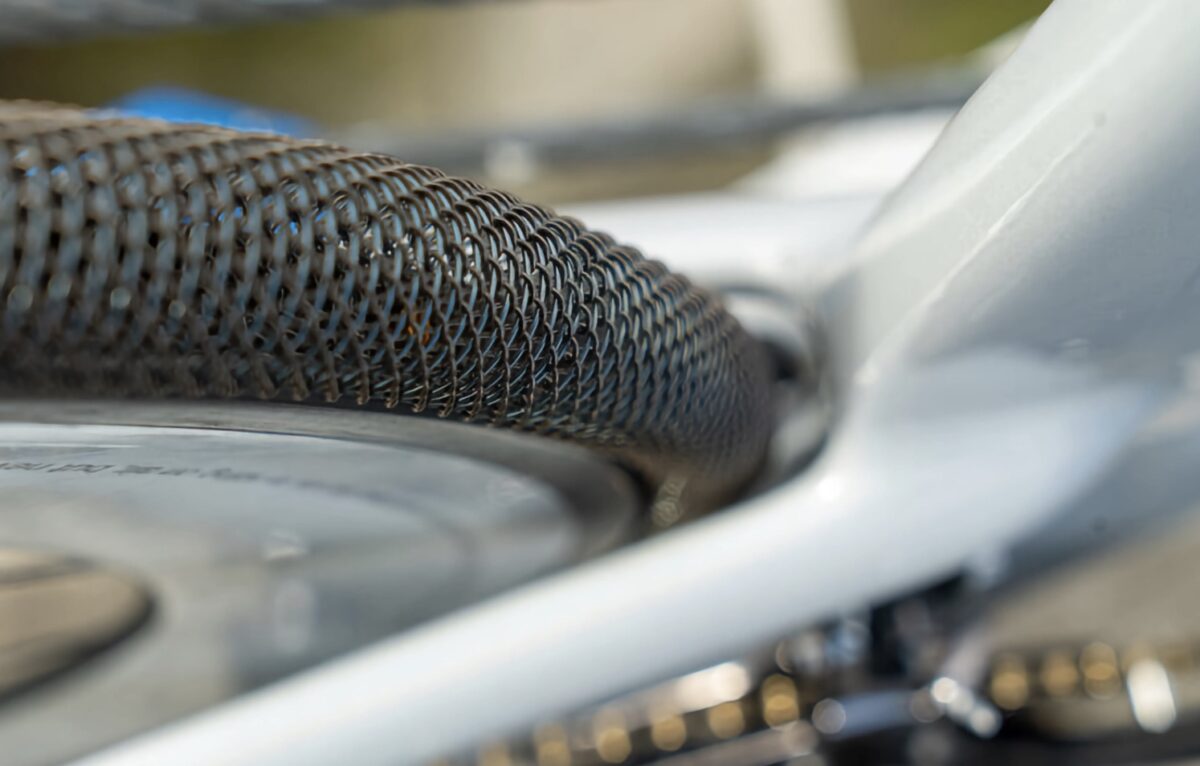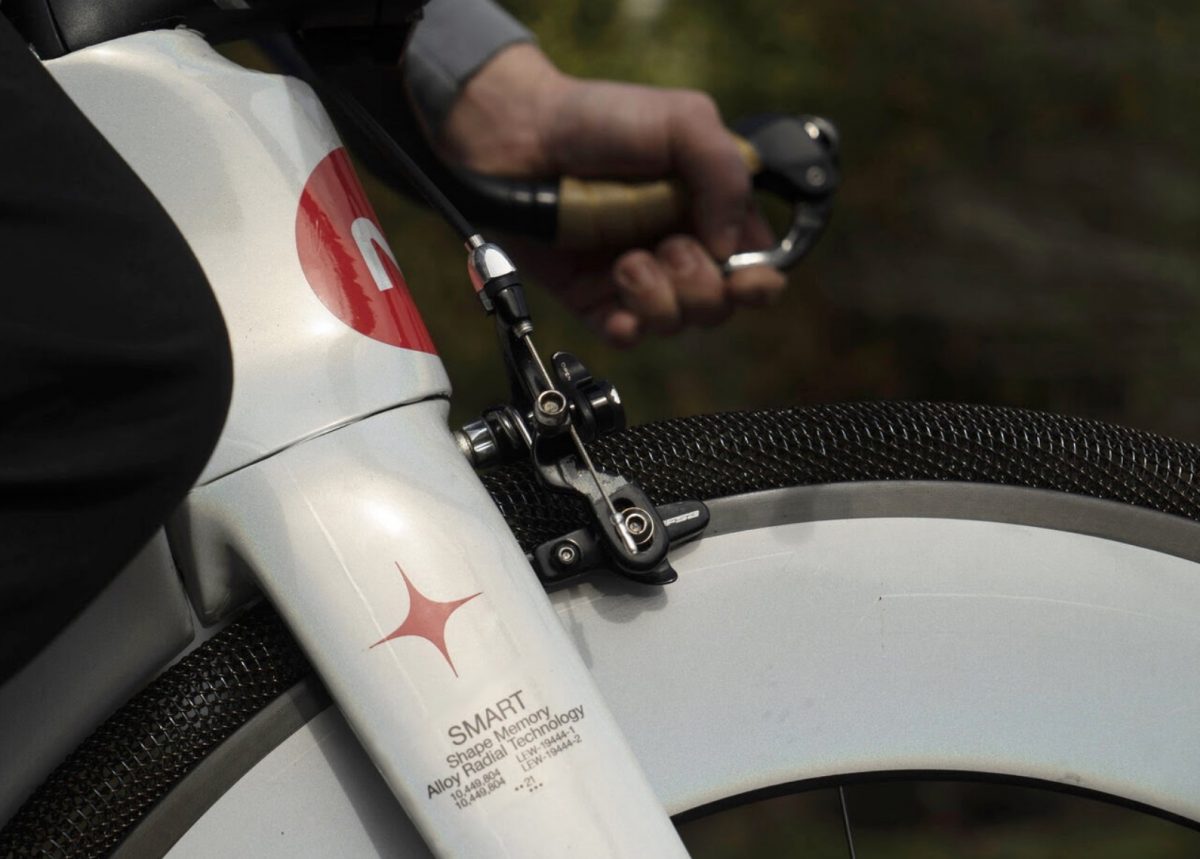(Photos: SMART Tire Company)
Portland-based engineer Calvin Young has combined his love of space exploration and cycling to create a new bicycle tire that is airless, as strong as titanium, and will never go flat.
“Bicycle tire technology is a unique combination of suspension and traction, so it will be interesting to see how it rides.”
— Shawn Small, Ruckus Composites
Young is part of the SMART Tire Company, a team of inventors and engineers that partnered with NASA to create the first-ever consumer application of their airless “shape memory alloy” (SMA) tire technology. On Tuesday the company announced their METL™ bicycle tire.
“Originally invented by NASA for use on lunar and Mars rover missions, the SMA tire is made from advanced, lightweight materials known as NiTinol+, creating a tire that is elastic like rubber yet strong like titanium, exhibiting perfect shape memory without ever going flat,” reads the press release.
SMART Tire Company was founded in 2020 by Earl Cole (a former champion of the show Survivor) and Brian Yennie, a blockchain engineer. Young began work on the concept while working as an engineering intern at NASA’s Glenn Research Center in Cleveland, Ohio. As a devoted rider, Young brought a cycling-specific vision to the project.
According to the company, the bike tires will be their first foray into the $250 billion global tire market.
Here’s more about them:
Advertisement
“The SMART Tire has a patented load-bearing design that takes advantage of the unique properties of shape memory alloys. These special metals can expand, contract, bend or unbend at a very rapid rate (like rubber) and with so much force that it can move heavy objects. Even with extreme deformation, the tire regains 100% of its shape through phase transitions at the molecular level.
Made in gold, silver and metallic blue, the SMART Tire Company’s METL™ bike tire has a stunning, space-age metallic look and feel.
Thanks to their ability to undergo phase transitions at the molecular level under strain, SMAs are unlike any other material, exhibiting thirty times the recoverable strain of ordinary steel. What’s more, SMART’s METL™; tires are eco-friendly, utilizing long-lasting materials that reduce rubber waste. SMART’s advanced research will establish METL™ tires as the premier high-tech component for the modern cyclist across road, gravel, mountain and e-bike applications.”
In addition to bike tires, SMART says they’ve partnered with micromobility provider and e-scooter company Spin (which is owned by Ford Motor Company and has a scooter fleet permit on file with the City of Portland). In the bike industry, SMART is already working with Felt Bicycles on R&D.
Our resident expert and NASA buff Shawn Small, founder and engineer at Portland-based Ruckus Composites, says he’s eager to learn more about the tires. “Bicycle tire technology is a unique combination of suspension and traction, so it will be interesting to see how it rides; there are plenty of applications when zero-maintenance is the priority, and these tires will be great to try.”
SMART spokesperson Jordan Wiggins says the new tires will be available to ride in early 2022. Stay tuned to SmartTireCompany.com and @SmartTire on Twitter for updates.
— Jonathan Maus: (503) 706-8804, @jonathan_maus on Twitter and jonathan@bikeportland.org
— Get our headlines delivered to your inbox.
— Support this independent community media outlet with a one-time contribution or monthly subscription.








Thanks for reading.
BikePortland has served this community with independent community journalism since 2005. We rely on subscriptions from readers like you to survive. Your financial support is vital in keeping this valuable resource alive and well.
Please subscribe today to strengthen and expand our work.
One small nitpick: no Survivor spoilers!! Been working through way too many seasons during covid, but will no be skipping whichever season has Earl it now!
But that aside, this is cool. Really cool. I would definitely want to try these out, geez who wouldn’t? Materials science is the unsung superstar of so many modern innovations.
Any idea if their design requires a different / new style of rim interface or is it backward compatible with the conventional bike rim?
Great question! The goal is to maintain backwards compatibility with the largest cross-section of the market. We don’t want you to have to ditch your favorite components–and want to make things easy on all the mechanics out there!
For all the arguments made on behalf of ebikes, talk about the sweat and speed of just being able to swing your leg over and go for a ride without worrying about tires, stairs, batteries…
please dont be tubulars, please dont be tubulars, please dont be tubulars…
I’m curious how these will compare to regular tires in terms of weight, traction, rolling resistance, etc.
From what I’ve read, all currently available airless bike tires add significant and noticeable drag, compared to their pneumatic, rubber alternatives. Most also have harsher rides and other performance-related drawbacks. It would be great if someone could create a flat proof tire that has reasonably similar performance characteristics and longevity compared to existing options. I certainly would be willing to pay a significant premium for the convenience and peace of mind of knowing that I never would have to carry around pumps, tire levers, tubes and patches again.
Let’s get these tires out on our MUPs and run through the debris and drug needles for some testing.
I can’t imagine that bare metal gets much traction on hard, smooth surfaces. Are the photos just prototypes? Is there a rubber traction surface molded over the NiTinol in actual road tires?
When used as a tire, it is actually woven. The Verge just did a NiTinol explainer video that has some interesting footage of the Rover tires in action. https://www.youtube.com/watch?v=Pn-6bGORy0U. (Rover tire bit starts at around 4:22)
Was thinking the same thing. It looks like the metal mesh is dipped in something, presumably grippy. My concerns would be for how that wears and the cost of the tire.
Yes–these are just prototypes showing off the internal metal structure! We didn’t do a great job explaining that–but the final product should look (and feel) just like a regular pneumatic tire.
It will be interesting to see more information. The press releases have been pretty thin on details. There have been a lot of attempts to unseat the pneumatic tire in transportation over the last 130 years without much success. Best of luck to the development team.
Thanks Jon! We’re certainly looking forward to sharing more details as they become available. It would be quite a feat, but I think this technology does have the potential to replace pneumatics.
Will they make 20″ and 24″ tires for big cargo bikes? Flat tires are not good on big cargo bikes.
Eventually, we hope to make them in all standard sizes! We’ll be starting with 700C for obvious reasons but should quickly branch out from there.
What happens when you run over poop? Don’t want that rattling around for days.
maybe depends on the type of poop
For sale?
I am curious about whether they will make them in 26×4 size for fatbikes. And what the comparable mileage will be.
Well past twenty years ago one of my friends worked as a tech editor at JPL in Pasadena. He would regularly tell of things he found in the literatue. One of the new items was nitinol, called the metal with a memory. It was being researched for such applications as a diaphragm which could pump liquid by changing shape with a change of temperature. I believe it has also been used in eyeglasses frames. It would be great to discard my pump.
I would have been really excited about these if they had been invented before tubeless tire technology was already in a mature state–because being flat-proof is nice, but so is being able to vary your tire pressure for riding conditions.